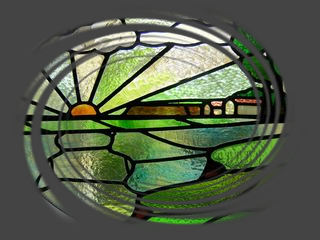 |
Mud and Coal... |
 |
Mud and Coal... |
Mud and Coal
The pictures in this gallery are from trips with the South Wales Geologists' Association to Selar Opencast mine and Ffos y Fran opencast mine in South Wales. They show some of the geology and also some of the equipment used to extract the coal past and present
Each picture has a caption, some further information is provided here.
Coal is formed when dead plant matter decays into peat and is converted into coal by the heat and pressure of deep burial over millions of years.[2] Vast deposits of coal originate in former wetlands (called coal forests) that covered much of the Earth's tropical land areas during the late Carboniferous.
The plants in the coal seams are so decayed and compressed that they are not able to be identified, but plants that were encased in mud or sand can be found as wonderful fossils. if you want to see reconstructions of the fossils as living plants there is an excellent leaflet created by my better half and available as a download on the South Wales Geologists's Association website http://swga.org.uk/carboniferous-fossil-plants
During the Upper Carboniferous the land that is now the UK was only a few degrees north of the equator and had a warm tropical climate and was low lying and swampy. The plants which died fel into this swamp and did not rot fully away. When this material was covered over and compressed with more rock being laid on top it became the coal seams. The sand and mud that was laid down when water levels were higher and the swamp was inundated by the sea became the sandstones and mudstones respectively.
Selar Opencast Coal Site is located approximately 1.5km south of Glynneath in the Neath Valley.
The site was originally opened in 1997 and planned to be miniing until 2010. It was in fact working until 2015 when it was "mothballed" as a result of falling coal prices making it uneconomic to continue work.
The coal here is derived from five main seams locally known as the Four Foot, Six Foot, Cornish, Nine Foot and Brass. Sadly I do not know which seams that I was looking at.
The pictures of the seams and overburden give a clear view of just how much rock has to be moved in order to obtain the coal from the mine.
The pictures of fossils include Stigamaria which are the roots of massive club moss "trees". they also include roots abd burrows in the seat earth which is the soil that was generated at times.
Ffos-y-Fran is a huge opencast and land reclamation scheme to the east of Merthyr Tydfil. The
The Ffos-y-fran Land Reclamation Scheme is planned to be completed in two phases. The end coal of production by 2022, restoration will be finalised by 2024 which will then be followed by a five year aftercare.
The pictures here include more of the overburden and seams showing the huge scale of the site. There are also more pictures of fossil plants once again stigmarian roots and rootlets, and once again some of the huge equipment that is used on the site
In addition there are some that are specific to this site because it is the site of old mine workings and old slag heaps.
Picture 37 shows reddened (burned" former slag. This was probably an underground fire that smouldered for a long period of time and may have kille dplants above or may have had vert little surface expression.
Pictures 38 to 41 are of old pillar and stall mine workings that have been uncovered during the excavation. You can see in a couple of the pictures that these seams were about waist high (1-1.5m) and therefore you can understand that when the roof was in place the miners would have had to have crawled between the pillars. The risk that they had was in overmining the pillars they could cause a collapse which would have been devastating! It is these pillars of coal which are being mined and the sale of these is the profit that is supposed to pay for the reclamation work. I know that there have been disputes betweeen the developers and the council regading payments, but this page is about geology not politics!
Pictures 42 and 43 are of a fossil tree which is in life position in one of the sandstone layers. This fossil has been formed by the sand around the base of the tree fern solidifying and then the tree eventually rots away and is filled by other sand. The slight discontinuity at the surface allows the fossil to be seen.
Picture 44 is of crystals within the sandstone. I need to ask my friends who are mineralogists to identify them for me.
Pictures 45 to 47 are of old drams which were found when excavating the site. In the times when this was working as an underground pit, things would have been repaired as much as they could be, but when that was no longer feasible or economic they would have been parked out of sight and what better place than od mine workings
The pictures of plant specimens are from our collections mostly from Selar. Details will be adde when I get them from my wife!
https://en.wikipedia.org/wiki/Ffos-y-fran_Land_Reclamation_Scheme
https://www.merthyrsw.com/projects/ffos-y-fran/
https://www.merthyrsw.com/projects/ffos-y-fran/history-timeline/
https://www.coal.com/operations/operations-selar/ Out of date, but some useful information
http://www.welshcoalmines.co.uk/index.html Site with a lot of information about specific mines
https://www.bgs.ac.uk/research/highlights/2015/southWalesCoalfield.htmlBGS Satellite study of ground motions in the 1990s in the South Wales Coalfield
"https://www.swansea.ac.uk/swcc/Swansea university Social History project